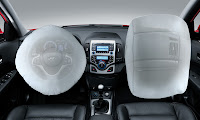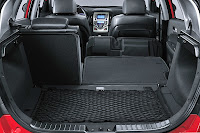More of rebadged Cee�d than an autonomous model aiming at a different sub-category of compact car buyers, the i30 is another example of what NOT to expect when seeing eye-popping concepts� After the video follow the jump and click �Read More�� below to check out the official press release along with a high-res image-gallery.



































PRESS RELEASE: Hyundai Introduces i30 at Geneva
All-New Entry into the European C-Segment
Styled in
New naming system for European model lines bear i prefix
(March 6,
With the i30 Hyundai introduces a new model range firmly positioned in the mainstream C segment. Styled in the company's Russelsheim Design and
Creative Flair � the exterior
Flowing curves, emphasised by strong character lines highlight the broad stance and long wheelbase of the i30. The clearly defined unbroken waistline unifies the classic proportions. The effect is conservative, yet exiting, giving a dynamic impression of performance and capability.
The pronounced dual intake frontal styling seems to mould effortlessly into the bonnet and A pillar lines. The upsweep of the rear window lines mirrors the lower character line. The harmonic effect creates a distinct and dynamic posture.
The sculpted rear appearance is achieved by a combination of qualified curves that extend the waistline and reflect the curvaceous front and side styling. Every element of the design works in harmony. The seemingly effortless interaction of front and rear light clusters, unobtrusive roof spoiler and superb front proportions, all contribute a powerful sense of proportion and purpose.
Dynamic refinement � the interior
The long wheelbase and generous width of the i30, combined with Hyundai�s acknowledged skill in interior space packaging have produced an interior fully focused upon class-leading comfort, functionality and practicality.
Dynamic refinement has been applied to every aspect, including air management, the light airy ambience, seating comfort and intuitive ergonomics.
The i30 was conceived from the beginning as a driver�s car. The clarity of the instruments, tilt and telescope steering wheel, supportive bucket seats and optimal gearshift positioning are all evidence of this. For extra clarity, LCD technology has been used for the central info display and the instrument panel mounted display and warning lights. Generous directional air vents ensure optimum interior air management. Two-tone interior trim, with metallic soft paint treatment, together with special attention to the upholstery fabrics and materials has produced a vitalising and fresh, highly �European� interior environment.
Blue instrument lighting
Hyundai has adopted LED based blue instrument and minor control lighting throughout their upper market ranges. The advantages are less eyestrain and fatigue under all ambient light conditions, helping to maintain peak driver alertness and vision.
For years now Hyundai have been proving that a car does not have to be large to feel spacious or carry a premium price to offer an intelligent interior. The i30 is just the latest expression of this. Intuitive ergonomics are evident in all of the minor controls. The positive feel of the steering wheel audio/communication switches and column stalks, together with the easy to hand positioning of heating, air conditioning and power windows and mirrors amply demonstrate this. The easy access to sunglasses holders, map pockets and other stowage and storage areas are another Hyundai strength that characterises the i30. Even the positioning and precise feel of the automatic gearshift has been further optimised. All contribute to the reality of a driver�s car.
Seating to inspire superlatives
A car that offers above average sporting appeal must also provide the supportive seating to enjoy it. The front seats and contoured rear seats of the i30 provide long distance comfort and support. Attention has been paid not only to the form, with orthopaedic design input, but also to the stitching and materials used. The result is seating comfort designed to meet and match the very best European ideals.
The ideal integrated interior
The i30�s dimensions at 4,245 mm long, 1,765 mm wide and 1,480 mm high, fit i30 totally to current C-segment expectations. In addition the long wheelbase of 2,650 mm offers superior inside spaciousness, which has received the full force of Hyundai intelligent interior design. The extra space allowed the designers to optimise every aspect it. The result is increased freedom of movement, optimal seat and instrument positioning and increased comfort. Both front and rear legroom and headroom are well above the accepted average.
Rear space with the capacity to convince
The i30 matches above average occupant space with generous, easy access luggage capacity. A useful and fully useable 820mm length 1020mm width and 558mm height in the luggage area gives an impressive 340litres load volume with the rear seats upright. With the rear seats folded flat the load space length and load volume are increased.
Also, as the i30 is a Hyundai, utility and convenience have not been overlooked. As well as the standard luggage cover, a restraining net is optional. Hyundai have always been recognised for their generosity of equipment at all trim levels, and the i30 builds upon that tradition. The range of standard equipment combined with a full selection of reasonable cost extras, allows i30 customers to fully tailor their car to their wishes.
Engines and transmissions
A choice of three petrol, combined with manual or automatic transmission and three diesel power options means the i30 can meet virtually every driving, or geographic powertrain preference. All petrol engines have 16v dohc CVVT and variable inlet technology. All diesel engines can be best described as state-of-the-art and are mated to a manual gearbox.
The i30 offers a wide range of engines. At the entry-level, Hyundai�s new 108PS 1.4l petrol engine offers a sparkling combination of fuel economy and performance with 13.5kg.m torque. A new1.6 engine gives 121PS and 15.4kg.m torque, while the range topping 2.0 offers 140hp with 18.8kg.m torque.
In terms of diesel a new 1.6 CRDi is available in 90PS and 115PS versions, both with 26kg.m torque. At the top end, the 2.0 CRDi puts out an exhilarating140PS with 31kg.m torque. All feature variable geometry turbo charging (VGT), low friction balance shaft technology and high-pressure common rail diesel injection for minimised engine originated NVH.
Transmitting the power
Regardless of advances in automatic technology, manual transmission remains the favourite for European drivers. The 5-speed all-synchro transmission of the i30 has been specifically engineered to match the sporting nature of the car with short throw and really precise shifts.
Suspension and braking match the performance
In any of the five available launch versions the Hyundai i30 offers a dynamic, yet cultivated driving experience. Fitted with MacPherson strut front suspensions and multi-link rear suspension has been adopted to perfectly complement the high design rigidity. Ventilated 10 inch discs front and solid 9 inch rear* with 4-channel ABS and optional ESP* mean the dynamic appearance is matched to real on-road handling control. As regards performance choice, a range of 15, 16 and 17inch alloy wheels, with low and ultra-low profile tyres add visual impact to the sporting dynamics. The result is a car that simply demands to be driven.
Uncompromising safety
Like every other Hyundai, the i30 was safe even before it reached prototype stage. Advanced design systems and sophisticated computer simulation, combined with intensive component testing meant that by the time the real tests
came only conceptual fine-tuning was required. That is typical of the Hyundai approach to safety. It begins on the drawing board, is thoroughly tested by prototype stage, and fulfils every expectation on the road.
Passive safety
The i30 is fully equipped to protect. In terms of passive safety it features dual front, side, and curtain airbags, active headrests, seatbelt pretensioning and seatbelt reminders. Also, as with every Hyundai vehicle, the passive safety features are fully grounded in a state-of-the-art safety structure. This includes deformable zones, occupant protection cell and 3-way load distribution technology. Further rigidity has been achieved with reinforced A-pillars, strengthened bulkhead, front and side members, toughened B and C pillars and full-length side impact protection.
Peace of mind features
Customer expectations in the C category have risen constantly over the past decade. The i30 is equipped to meet them. Active front headrests are optional. The interior rear view mirror is electro chromatic self-dipping (optional) to reduce night driving eyestrain. The heated power exterior mirrors fold electrically to prevent breakage in tight situations. Rear mounted parking sensors that give and audible warning are also optional. That all adds up to extra peace of mind. ABS/ESP 4-channel ABS and deselectable ESP (optional) are standard on the i30 for advanced active safety.
Welcome to Hyundai�s i world
While in the past, names of Hyundai vehicles had been chosen to express the values inherent in or associated with individual Hyundai models, Hyundai is now taking a more holistic approach to its nomenclature. Future vehicle names will display a clearer technology-orientation and have a common core that is easy to understand for everyone.
Hyundai chose an alpha-numerical code that could establish a link between technology and the Hyundai brand�s core values. With the �i�, Hyundai chose the letter that could carry both messages. The letter �i� has a long tradition as an icon for technology products. Furthermore, as a frequently used icon, the �i� is already established across
In addition, the �i� is also part of Hyundai�s brand promise. In the 1990s, Hyundai changed its entire corporate focus, moving away from its original business philosophy of producing �good-bargain� vehicles, to acquire a more sophisticated profile. Hyundai wanted to become more inspiring. Today, the will to �inspire� forms one of the cornerstones of the Hyundai brand. The letter �i� recognizes this fact and transports it to consumers.
The i30 is the first Hyundai to carry the �i� in its name. The number 30 is the numerical equivalent of the letter assigned to the i30�s segment, the European C segment.
i + numerical equivalent of segment letter:
i10 = A segment
i20 = B segment
i30 = C segment
i40 = D segment
i50 = E segment
For future derivatives or special segment models, an additional letter will be added to the i:
i30 CW = C segment cross-wagon
The new nomenclature will be applied only to future vehicles that are sold in
Technorati: Hyundai+i30, Hyundai, Arnejs, , Video, Geneva+Motor+Show, auto+news, car+news, automobile, cars, automotive, vehicles, Carscoop, blogs, 2007, pictures, images
 12:32 PM
12:32 PM
 Unknown
Unknown


2 comments:
This can really help a lot of people i feel like. Thanks so much for this article!
Save thousands
If truth be told informative and valuable detail is here.
Save thousands
Post a Comment